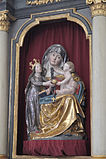St. Peter and Paul (Halsbach)
The Catholic parish church of St. Peter and Paul in Halsbach , a district of the market town of Dürrwangen in the district of Ansbach in the Bavarian administrative district of Middle Franconia , is essentially a Romanesque basilica that was built at the beginning of the 12th century. In the middle of the 18th century the church was redesigned in the Baroque style. Valuable pieces of equipment have been preserved from the Gothic period.
history
As early as the 9th century, a wooden church is believed to have stood on the site of today's parish church, which was replaced by a Romanesque basilica around 1110. In the 15th century, the three were ships of the church with a common gable roof covered. From 1751 the church received its baroque interior. The west tower was provided with an octagonal structure and a bell dome.
Cemetery wall
The essentially medieval cemetery wall was renewed around 1754. It is broken by two gates. The coat of arms of the Teutonic Order is emblazoned at one entrance, carved in stone.
architecture
The three naves of the nave are divided into four bays . They are closed in the east by semicircular apses , the middle apse is extended like a choir . Round shield arches over sturdy pillars separate the aisles from the main nave. The coat of arms of the Teutonic Order is affixed in a cartouche above the choir arch .
Furnishing
- Embedded in an altar in the right aisle is a third Anna from 1470/80. On the altar stands the evangelist Luke with his attribute , the bull.
- A Pietà from around 1500 is kept in the left aisle .
- A relief carved from linden wood in the southern side apse depicting Jesus and the twelve apostles is dated around 1500/10.
- The life-size crucifix in the nave was created around 1510/20.
- The baptismal font dates from the 16th century. It is crowned by a carving of the baptism of Jesus from 1752.
- The Madonna on the crescent moon, who crushes the snake's head, dates from the 18th century.
- The sculptures of St. Leonhard , St. Sebastian and St. John Nepomuk also date from the 18th century .
- The pulpit was created around 1745 for the church of the Carmelite monastery in Dinkelsbühl . The relief on the back wall of the pulpit depicts Queen Esther , who campaigns for her Jewish compatriots with the Persian King Ahasuerus .
- On the donor picture on the west wall, Jesus is shown on the cross with Mary and John. At the bottom of the picture you can see the donor family with numerous deceased nappy-changing children. The left picture shows Aloisius von Gonzaga , the right the holy Apollonia of Alexandria with her attribute, the biting pliers.
- A stone epitaph with the reclining figure of the deceased was moved into the interior after the renovation of the church and set into the wall.
literature
- Georg Dehio : Handbook of German Art Monuments - Bavaria I - Franconia (arrangement: Tilman Breuern, Friedrich Oswald, Friedrich Piel, Wilhelm Schwemmer u. A.) . Deutscher Kunstverlag, Munich 1979, p. 342.
- August Gebeßler : City and district of Dinkelsbühl (= Bavarian art monuments . Volume 15 ). Deutscher Kunstverlag, Munich 1962, DNB 451450930 , p. 153-155 .
- Churches in the Hesselberg region. Church of St. Peter and St. Paul Halsbach . (Leaflet in the church)
Web links
Individual evidence
Coordinates: 49 ° 5 ′ 16.9 " N , 10 ° 23 ′ 37.8" E








